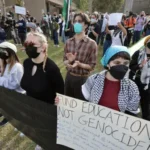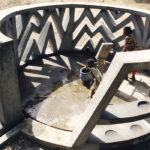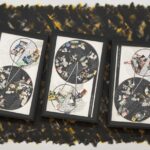MTL Reports: #GreatReturnMarch
MTL Collective
What follows is a report on the innovative tactics and strategies deployed in the popular Palestinian resistance of the #GreatReturnMarch, including counter-tactical moves, art, and inventions. But first some background to Gaza and the march. May 15, 2018, marked the 70th anniversary of the Nakba when 700,000 Palestinians were driven out of their homes by armed Zionist militias to establish the State of Israel. A majority of those living in Gaza today are refugees from towns and villages a few miles away. They continue to wait to return to their homes. One of the objectives of the Great Return March is to move from waiting to enacting that right.
The Great Return March began on March 30, 2018, to coincide with Palestinian Land Day. It is “mass popular protest” of a population of two million against the devastating blockade imposed by the state of Israel since 2007. However, it is probably best understood as a Palestinian rebellion against the concentration camp they find themselves in, and as popular resistance to the liquidation of their right to return home in the Age of Trump. After a popular Facebook post from December 2017, a youth committee was formed and outreach and organizing began for the Great Return March. Conceived away from narrow Palestinian factional identities and political parties, and Hamas as an organization and a ruling authority in Gaza was also not involved. The initiative centered on Palestinian civil society. The process involved coordination with various sectors and representative bodies in towns and refugee camps. Forty-five days later, participation swelled to 200,000 Palestinians.
On May 14—the eve of the 70th anniversary of the Nakba and the day the U.S. Embassy in Jerusalem opened—Israeli snipers killed 62 Palestinians and wounded over 2,770. Legs and knees were intentionally targeted to maim, literally denying participants the physical ability to march home. This Israeli state practice reflects a calculated strategy to convert the status of the refugee into one of permanence. It has also sought to thwart the mass appeal of the Great Return March by creating a life-threatening environment and thus by pushing participants to abandon non-violent tactics. In response, a diversity of tactics and strategies emerged to counter the deadly force deployed by the Israeli Army. As of the date of this report, the Great Return March continues.
It is important to note that the creativity deployed in the Great Return March has drawn on previous de-occupations of space, including public and quasi-public parks, which we witnessed in Al-Kasbah square in Tunis, Tahrir square in Egypt, Puerta del Sol in Madrid, and Zuccotti Park in New York City between 2010-11. The land across the militarized “fence” by Israel has become fertile grounds for a new set of social relations and reorientations in the way we treat one another. Banners and signs both beautiful and resonant have been made collectively, art has been used to heal and wage war in an imagination that continues to be colonized, and initiatives have been taken to enact ideas of refusal and resistance in furtherance of living a life with dignity. Precisely for this reason, Israel targets them for death and maiming.
We share these images from the Twitter handle @greatreturnma established in February 2018 to act as voice from the ground. Its description states, “#GreatReturnMarch, a popular, peaceful march by millions of Palestinian refugees going back to the lands from which they were displaced in [the] 1948 War.” The images and accompanying text consider desire, not pain. We learn with Palestine how to be free.
* * *

Encampment preparations happened a month earlier. On the day people march from cities, towns, and camps in Gaza towards the “fence” with Israel where indefinite encampments are set up along the strip.

Social time in the protest encampments.

A distant view of Gaza from Israel. Trees in the foreground are planted to obstruct the view of Gaza for settlers living on the Israeli side of the fence. The image below is a view of one of the protest marches on the Gaza side of the fence. Israeli snipers respond by killing at least 15 Palestinians and wounding hundreds.

Encampments and weekly Friday protests continue near the fence. To combat sniper fire, a Friday of Tires is declared the following week. People from various walks of life gather tires and amass them to set on fire so that the smoke can obstruct the snipers view.

Persistent walls of smoke manage to effectively obscure protesters’ deaths and injuries. One of the images illustrates the view of the snipers.

A diversity of tactics proliferates with self-organized affinity groups supplementing the work in the camp, including the Bolt-Cutter Brigades and Tear-Gas Response Brigade.

Images in the top row: Israeli forces drop leaflets on the encampments warning Palestinians to go home and threatening them with lethal force, claiming “you have other ways, your future is in your hands.” In response, on the bottom, protesters create their own leaflets and sent them over to the Israeli side by kites. They read, in essence, “You, Zionists, you do not belong here, don’t listen to your leaders and commanders, leave our land.”

Israel deploys tear gas-dropping drones against the Great Return March, using new technology that can allow the army to use “riot” control measures in areas previously thought unreachable. On the right are balloons to visualize the losses of life and the oppression being experienced on the ground.

Participants in the Great Return March continue to innovate tactics of resistance, here in relation to tear gas.

Journalists covering the Great Return March are intentionally targeted.

Jasbir K. Puar writes in her recent book The Right to Maim. Snipers intentionally target limbs of protesters when they are not shooting to kill. Israel kills 16 human beings and wound over a 1,000 in one day. This makes us focus on the number of the dead when in fact Israel is deliberately pursuing a strategy of causing permanent disabilities in order to shackle entire families from the ability to resist by imposing a loss of income that further pushes families into poverty while, simultaneously, acting as a general deterrence to current or prospective participants. However, often those shot, if they can, return to the Great Return March in an act of defiance and perseverance.

An example of how Israeli snipers have targeted limbs. Here, the artificial limb of a participant targeted by Israeli snipers. This person lost his leg in an Israeli bombing during the war on Gaza in 2014. In the other image, one observes the production of artificial limbs for the high proportion of amputees in the Palestinian territories because of the violence of the occupation.

Popular makeshift solutions to tear-gas inhalation and sniper fire.

A critical component of the encampment infrastructure are volunteer-run medical clinics. The last image on the bottom right shows one such clinic being being targeted with tear gas by the Israeli Army.

Tires have other uses at the encampments, including beautification, organization (e.g., as tables for eating together), and memorialization (i.e., to honor fallen martyrs as part of the Great Return March).

Art-making, culture, fun, and caring for the land are central activities at the encampments.

Creativity and joy infuse visits by students to the encampments as they travel by bus to be part of the activities. Here, the balloons have the names of the towns and villages, now in Israel, from which each of the students comes.

Here, we see reading circles and free university classes at one of the encampments. In the right-hand image, a professor organizes to teach a class. The other images capture a Library & Books for Gaza initiative.

Food and group cooking are an important part of giving and sharing, building relations, and organizing in the encampments. The acts of generosity are reminiscent of early periods of the uprisings that swept the Arab world and beyond beginning with Tunisia in late 2010.

The day the U.S. Embassy opens in Jerusalem a massacre is perpetrated by Israel against protesters, resulting in 62 killed and over 2,277 injured (these are conservative estimates).

Acts of solidarity are occurring to break the silence by taking to social media and to the streets. Images clockwise: a call to Boycott, Divest, and Sanction Israel (BDS); A Decolonize This Place sticker is placed on an information booth reporting on the U.S. Embassy opening in Jerusalem in Ocean Hill, Brooklyn; “Gaza” is spray-painted on the wall of the Nostrand Subway station in Brooklyn; and an archival image of a giant banner drop (90 ft x 45 ft) off the Manhattan Bridge, stating “GAZA in Our Hearts” and also calling for Boycott, Divestment, and Sanctions of Israel.
Amin Husain and Natasha Dhillon are MTL Collective, a collaboration that joins research, aesthetics, organizing, and action in its practice. MTL is a founding member of Tidal: Occupy Theory; Direct Action Front for Palestine; Global Ultra Luxury Faction (G.U.L.F.); Decolonial Cultural Front; and most recently MTL+, the collective facilitating Decolonize This Place, an action-oriented movement and decolonial formation that blurs the lines between art and activism around five strands of struggle: Indigenous Struggle, Black Liberation, Free Palestine, Global Wage Worker, and De-Gentrification.







